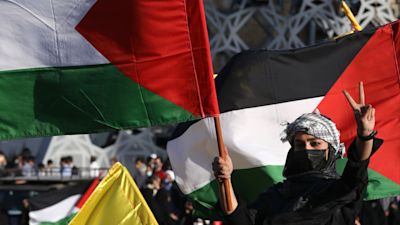Israel-Palestine conflict: The range and scale of Hamas' weapons continues to surprise

With car horns blaring and armed guards raising their hands to make the ‘V’ for victory sign, a fleet of military vehicles moved at walking speed through Rafah, in the southern Gaza Strip.
The pace was deliberately slow - commanders wanted everyone in the crowd to see what was on the backs of the low loaders - Hamas weapons which at times overcame Israel’s Iron Dome defence system during last month’s 11-day conflict. Pictures and videos of the celebratory parades which were circulated on Facebook last week appeared to show the ‘Ayyash 250’ being driven through the streets - a projectile which Hamas’ armed wing claims can reach anywhere in Israel. A collection of shorter-range Q20 and S40 rockets, which cost a few hundred dollars each and can reportedly reach 12 miles and 24 miles respectively, were also displayed. But a parade which was intended to indicate enduring military strength, will have raised further questions about who is behind that capability.
The moment Hamas militants fired a large barrage of rockets into Israel
Despite the claim by Israeli Prime Minister Benjamin Netanyahu that the May offensive had dealt Hamas a “blow it cannot imagine”, the range and scale of its weapons continues to surprise. “Of course you can see the hand of Iran in that” says one senior European diplomat who described Tehran’s relationship with Hamas as “complicated but real”. Israel is alleged to have recently orchestrated a series of covert attacks in Iran - Iran has threatened to retaliate but has struggled to find a way which does not risk an all out war. Governments around the world have been trying to work out the extent to which the latest Gaza conflict can be seen as part of this broader, shadow war between Israel and Iran. The military capability of Hamas indicates significant external support from Tehran, according to Israeli officials.
“They’re not out of rockets”, a senior Israeli source told ITV News, speaking on condition of anonymity and striking a contrasting tone to the triumphalism of some political leaders in Jerusalem.
“They have enough rockets to continue but they’re the cheapest type. They may be short of longer range rockets. “The big question is operationally whether they can launch what they have. This is where we had success, especially with long range rockets. But it’s not that they’re short of rockets, they have rockets.”
'I don't want to hear screams anymore': The young girl sleeping in fear in Gaza
The Israel-Gaza conflict explained: What's behind the violence?
On that last point, there is consensus. 4,400 rockets were fired at Israel during the conflict by Hamas and Islamic Jihad, but foreign intelligence officials estimate that “many thousands” remain. Hamas leader Yahya Sinwar said the group had used only “50 percent of its power” during a discussion with academics in Gaza yesterday. So how did Hamas gather and retain such a large haul? When Ismail Haniyeh, the group’s political director, gave a televised address following last month’s ceasefire, he heaped praise on Tehran for “…supporting and funding the resistance financially, militarily and technically”. And the group has said Iranian support is unconditional. Further evidence of help comes from its latest weapons, some of which have similarities to military tools used by Iran. For example, Hamas’ so-called Shehab drone appears to resemble Iranian machinery, superficially at least. “The budget is many millions of dollars each month. What comes in from states like Iran is a major part… The portion which comes from Iran has grown over the last twenty years,” the Israeli official said.
However - and significantly - Israel believes that Hamas’ decisions during last month’s conflict were made independently of Iran. Despite the obvious joy of the Tehran regime, Israel does not believe it was directing Hamas. “It’s not always all about Iran,” said a US diplomatic source, who warned that framing Hamas as no more than an Iranian outpost was a false narrative which might provide “useful PR” for both sides of the conflict. He said Iran is distracted by talks over a nuclear deal and will continue to prioritise the arming of Hezbollah, a Shiite group in Lebanon, as well as Houthi rebels in Yemen over Hamas, a Sunni organisation, in Gaza. “The relationship is more transactional than anything else,” says Neil Quilliam, an associate fellow with the Middle East and North Africa Programme at Chatham House, who interviewed interviewed 210 experts and policymakers for a paper on de-escalating conflict in the Middle East.
“Gaza is not an Iranian priority, it’s at the bottom of the pile… It was always more Hamas leveraging its relationship with Iran than the other way round.”